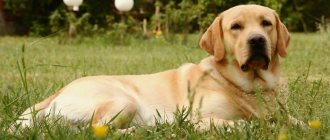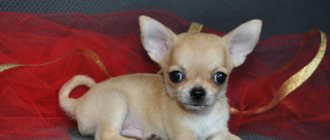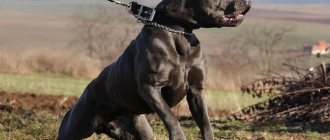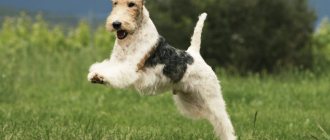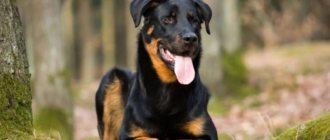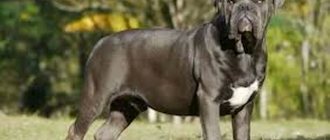The Standard German Pinscher is an energetic and cheerful dog that is very loyal to its people. It has strong protective qualities and is perfect for people as a companion dog. A clear disadvantage of the breed is intolerance towards other pets.
Let's look at other character traits of the German Pinscher, as well as breed standards and rules for caring for them.
Standard German Pinscher: history of the breed
This is one of the oldest breeds in Germany. It is believed that it originated during the Middle Ages from German turf dogs. Initially, standard German pinschers worked with grooms, assisting them in accompanying animals and catching rodents.
Later, the Pinscher breed received 3 varieties depending on the size of the dog:
- miniature pinscher;
- standard;
- big (became a Doberman).
Since the 19th century, in Germany, representatives of the breed are divided into long-haired schnauzers and smooth-haired pinschers. Each variety has its own standards.
This is interesting! The breed was officially recognized in 1884.
For the standard German Pinscher, two types of colors began to be recognized:
- ginger;
- black with orange markings on chest and muzzle.
In the post-war period, the popularity of these dogs dropped noticeably, and Carl Gustav Jung himself began restoring the breed.
Later, Doberman genes were used to change the difficult character of Pinschers.
Mating
Puberty in German Pinschers occurs at the age of 10-12 months. In some individuals, estrus may begin at 8 months; there is no need to be afraid of this. Regardless of the readiness period, early matings are not advisable. This can ruin the appearance of your pet, as well as cause various changes in the natural functions of the body. The bitch's body must mature to the end. After all, she has to carry the puppies, give birth to them, and feed them milk. The third estrus is considered optimal for mating. As for males, they should also be limited from early matings. The psyche and physiological characteristics of the dog must be ready to meet the bitch. The best age for breeding a male dog with the opposite sex is when he is two years old.
Interesting facts about the breed
There are several interesting points associated with the standard German Pinscher:
- The Standard German Pinscher became the breed of 2003. He received this title as the oldest species, which is now gradually disappearing. Thus, organizations for the protection of endangered dog breeds are trying to draw attention to this problem.
- Silhouettes of the standard German Pinscher can be seen in paintings by Jan Brueghel, Albrecht Dürer and Carl Vernet.
- Many people think that the standard German Pinscher is descended from the Doberman Pinscher. But the opposite is true - the Doberman was obtained by crossing a pinscher, a shepherd dog and a Rottweiler.
Doberman
- Height: from 61 to 72 cm
- Weight: from 32 to 45 kg
- Life expectancy: 12 to 13 years
- Temperament: intelligent, energetic, fearless, loyal, alert, obedient, confident
The Doberman Pinscher is a dog full of contradictions. Although he has long had a reputation as a daring and even sinister dog, loyal fans of the breed consider the Doberman to be the most loving and faithful companion. And no, “loyal” is not a euphemism for “loves only his master.” Believe it or not, the Doberman will be a balanced and friendly pet unless you threaten his family.
Did you know that the Doberman is a German breed of dog that was created by tax collector Louis Doberman to protect himself and the money he collected from thieves. To create an intelligent and loyal guard dog, he crossed short-haired German Shepherds with Rottweilers, Black and Tan Terriers and German Pinschers. Smooth-haired dogs such as greyhounds and Weimaraners may also have been part of his "recipe".
Created as a watchdog, the Doberman has an innate ability to not only protect its family, but also to anticipate dangers and threats . But if a Doberman is not socialized and trained to behave properly around strangers, he may become overly suspicious of guests in your home—a wariness that can develop into aggression.
Although most people are only familiar with the black Doberman with rusty markings, the breed actually comes in a variety of colors: blue (actually grey) with rusty markings; various shades of tan with rusty markings; and a light brown paint job called Isabelline, which also has rust marks.
WARNING! Keep in mind that white or cream Dobermans are a genetic mutation associated with serious health problems; they are not valuable and expensive rarities.
The Doberman's intelligence, trainability, and courage make it capable of fulfilling many different roles, from working police or military dog to family protector and companion. The Doberman is energetic, empathetic, decisive, alert and flexible. Only with close contact with his family, proper socialization and training will he not show aggression and other destructive behavior. A Doberman that is kept alone in the backyard will never become a loving protector but will instead become a fearful dog that is aggressive towards everyone, including its family members.
Breed standard
When describing the breed, it is worth focusing on the sophistication, grace and strength of these dogs. A distinctive feature of the Pinscher is its elongated muzzle. It is customary to dock the ears and tail of these dogs.
General characteristics of pinschers:
- The head is strong and long, without a bump on the back of the head, flat on the top.
- The muzzle is shaped like a blunt wedge. The bridge of the nose is smooth and straight. The jaw is powerful. Scissor bite. Number of molars – 42. No cheekbones. The nose is medium, its pigmentation depends on the color of the coat.
- The eyes are almond-shaped, close-set, dark, brown.
- The ears are triangle-shaped, long and narrow, hanging down along the cartilage. They can be stopped.
- The body is strong, muscular, elongated. The highest point of the body is at the withers. The back is straight. The body is round. Belly tucked. The chest is medium, drooping.
- The tail follows the line of the vertebrae, hanging down to the hock joint. May stop.
- The paws are narrow, even, long. The thighs are well defined and muscular. Fingers are gathered in a circle.
Price in Moscow: 10–35 thousand Russian rubles.
Color and coat type
The coat of standard German Pinschers is short, close to the skin, and very shiny. The standard establishes two types of colors: orange and black with orange markings on the chest and eyebrows.
Weight and height of the breed
The breed has two height categories: standard (45–50 cm) and dwarf (25–30 cm). The Doberman stands out separately.
The weight of standard German Pinschers varies from 14 to 21 kg, while miniature Pinschers range from 4 to 6 kg.
Disqualifying faults
Each club specializing in breeding miniature pinscher dogs has fairly strict requirements for members. And they can be disqualified even for minor flaws, for example:
- malocclusion (underbite, overbite, skewed jaws);
- deviation from standard height by 3 cm or more;
- presence of defects in color and coat.
In addition, dogs can be disqualified due to improper behavior, demonstration of cowardice, aggressiveness, or viciousness.
Pinscher character
The standard German Pinscher is a self-confident, active dog who is not a stranger to leadership and some notes of selfishness. Over the centuries of the breed's existence, it has ceased to be exclusively working.
Nowadays people prefer to have just a companion, so breeders select dogs with a gentler disposition for breeding. However, it is not so easy to remake genes: a dog can be a good pet, but only if it is trained in a timely and competent manner.
Important! Standard German Pinschers are quite jealous and are not very friendly towards other animals in the house, especially small ones.
Standard German Pinscher and children
Standard German Pinschers get along well with children, but it is better not to leave them alone with children. The point is that they may become jealous of their place or their toys.
In addition, these dogs easily get excited and can accidentally push the baby. Therefore, a dog of this breed can become an excellent play or sports partner for a child over seven years old who knows how to handle animals.
Nutrition
The Miniature Pinscher is a healthy dog breed with excellent immunity. She does not really need a balanced diet, as she has a strong physique from birth. However, this does not mean that the dog can be given just anything.
To keep your pet in good physical nutrition, we recommend feeding him dry food. This product contains minerals, beneficial extracts and vitamins, that is, everything that will ensure the animal’s normal functioning.
But remember that the abundance of food choices does not guarantee you a quality purchase. We recommend speaking with your veterinarian before purchasing a specific product. Let him examine your pet and recommend the dry food that will best suit him. Recommended class – super-premium.
But you shouldn’t give it to a puppy. It is better to feed a young miniature pinscher raw, lean meat and cottage cheese. A third of his diet should be stewed or boiled vegetables. Recommended cereals: oatmeal, buckwheat and rice.
You cannot overfeed your dog, otherwise it will become overweight and inactive. In addition, food abuse provokes digestive dysfunction in dogs. Be sure to ensure that there is fresh water in the animal's second bowl. Since the dog moves a lot, it needs to quench its thirst regularly.
How to choose a puppy
To make it easier for you to make your choice, answer a few questions for yourself:
- Which suit do you like best?
- What dimensions do you prefer? In order not to be mistaken with the size, it is enough to study the pedigree of the puppies' parents.
- Who is better for you: a boy or a girl? Girls are always more gentle and obedient, and easier to train. But if you need a security guard, it is better to buy a boy.
- Are the working qualities of a dog important to you? If yes, then it is better to take a 5-month-old puppy, when its character and inclinations are already visible.
- For what purpose is a puppy purchased (for exhibitions, for yourself, etc.)? If you need a companion, you can take a 1.5–2 month old baby. If you want to raise a champion, it is better to buy a six-month-old dog. At this age, it is already possible to determine the harmony of the physique and other details of the animal’s appearance.
Important! Genetics determines not only a dog’s appearance, but also its susceptibility to breed diseases.
As a rule, puppies are divided into 3 classes:
- pet is a pet, may have minor flaws;
- breeding – perfectly complies with the regulations, participates in further breeding;
- show - beautiful babies with excellent pedigree who participate in exhibitions.
Important! Before purchasing a dog, you need to find out about the reputation of the nursery and breeder.
Veterinary
Compared to many other breeds, German Pinschers live a long time - up to twenty years. Try to extend your dog's happy life and help her stay healthy and active for as long as possible.
Pregnancy and childbirth
The breeding stock of German Pinschers in Russia, unfortunately, is still small - the breed was and remains rare. Competently choosing the optimal parent pair can be difficult. Therefore, responsible breeders who advocate for improving the breed build a breeding strategy in advance, calculating it for several upcoming generations of offspring, and often travel abroad for matings. This is a large, painstaking job that requires special knowledge and experience.
The female German Pinscher is a good mother, she not only cares for the puppies, but also raises them
Pregnancy and childbirth in a German Pinscher bitch usually go without complications, and wonderful babies are born within the time allotted by nature, approximately 60 days after mating. On average, a nempina litter can consist of 5–7 puppies.
Possible diseases
Unfortunately, the breed has serious hereditary problems, including:
- von Willebrand disease;
- hip dysplasia;
- eye diseases.
A specific blood disease in the Pinscher is associated with poor blood clotting and is caused by a deficiency of the so-called von Willebrand factor. The disease can manifest itself in different ways, and certain forms are life-threatening for the dog. A test for this genetic disease can be done at any age, even for a newborn puppy. Even mild stages of the disease require constant monitoring and treatment by a veterinarian.
Violations of the genetics of color, manifested in its lightening, are also prevented by testing both the parent pair and already born puppies. This genetic defect is not dangerous to health, but dogs that are found to have it should be removed from breeding.
A German Pinscher can be red or black and tan, everything else is a breed defect
The pinscher should undergo simple clinical eye examinations for various diseases, including congenital ones, regularly, starting from the age of one and a half months - the earlier the problem is identified, the easier it will be to get rid of it completely or at least stop its development.
Your pet is sad and refuses food - contact your veterinarian immediately
When choosing a puppy, ask the breeders about the breed genetic tests of its parents and pictures for dysplasia. If such studies have allegedly not been conducted, this should alert you - there is a high risk of purchasing a sick dog.
Video: everything about the breed
Caring for puppies
Before your pet arrives at home, you need to buy:
- soft collar, harness, leash;
- shampoo, eye and ear cleaners;
- food, bowls, treats;
- bed;
- brush, guillotine;
- medicines against helminths, fleas and ticks;
- toys;
- diapers for the toilet.
The puppy needs to be given a secluded place, away from radiators and windows, so that the baby does not overheat or catch a cold.
You cannot walk with your pet until it is fully vaccinated. At most you can carry it outside in your arms. It is important to avoid contact between the puppy and other animals.
It is also necessary to secure the home for the new family member: remove wires, breakable, cutting objects, household chemicals - anything that can harm the baby.
How much does a miniature pinscher cost?
The average price of a miniature pinscher offered by Russian nurseries ranges from 10 to 30 thousand rubles. Private sales through free bulletin boards, where the seller indicates a price below 10 thousand, are conditioned by the absence of a pedigree or the presence of a breeding marriage.
If the purpose of purchasing a miniature dog is related to further breeding of the breed, then choose breed-class puppies. The maximum price is set for show-class animals - future winners of international competitions, and the minimum price is for pet-class dogs with small but acceptable deviations in appearance.
Do you like the article? 0
Caring for an adult dog
German Pinschers do not require any special care. These are healthy dogs that require a minimum of hygiene procedures.
Nutrition
When keeping a pet on industrial food, it is important to choose a high-quality product that will give the dog the necessary daily dose of useful elements. The disadvantages of such feeding include monotony and the possibility of allergic reactions.
When feeding “natural” it is important to maintain a balance:
- half of the daily norm should come from proteins (meat, fish, cottage cheese, eggs);
- the rest is supplemented with cereals and vegetables.
You cannot give:
- pork;
- baked goods and sweets;
- butter;
- potatoes, beans, corn;
- tubular bones;
- river fish.
Important! Your pet should always have a bowl of drinking water.
Exercise stress
Standard German Pinschers are very active dogs. In former times, they ran great distances accompanying stagecoaches. Today, a full walk for a dog should last at least two hours and include outdoor games (agility, freestyle, running with a bicycle).
Important! The Standard German Pinscher needs to be let off a leash so it can run freely. Therefore, it is worth taking care of a full training course. Obedience is the key to a dog's safety.
Training
The Standard German Pinscher is people-oriented and therefore highly trainable. This is a very smart breed that quickly remembers commands and is sensitive to the owner’s mood. But in order to achieve the best interaction with your pet, you need to work with him from puppyhood.
Today, the Pinscher has become a companion dog, so it is not recommended to have it as a working breed. If a guard is required, it is better to give preference to the Doberman Pinscher, since it is larger, although the German Pinscher also carefully monitors its territory.
Standard Pinschers are good manipulators. In this regard, it is important to behave consistently and firmly with them. When training, it is necessary to choose motivational methods, rewarding your pet for doing what he likes best (attention, play or treats).
Hygienic care
Since Pinschers have a short coat, they do not need to be brushed for a long time. Periodic wiping with a towel and massage with a brush once every 7 days is enough. This breed can be bathed no more than once every 30 days.
The weak point of pinschers is the ears, especially uncropped ones. It is recommended to inspect them a couple of times a week and clean them if necessary.
Pinschers' eyes are treated as needed. Nail trimming is recommended monthly. Also important for maintaining health is treatment against parasites.
Key points in training
The breed is completely human-oriented, which means that even a teenager can cope with training a Pinscher. These dogs are very smart, quickly understand commands and respond to them. But in order to achieve complete mutual understanding, you need to start training from early childhood. Literally from the first minutes of his appearance in the house, the pinscher must understand that the person is in charge.
Experts do not recommend taking German Standard and Miniature Pinschers as working dogs. Indeed, now the breed is used as a companion dog. If a family needs a security guard, then it is better to consider the Doberman option, although Zwerg can handle protecting the apartment.
These dogs are considered talented manipulators, so only a strong, strict person can get along with them. The best training method is motivational. It is important to set priorities correctly and reward your pet with affection and treats in a timely manner.
From the first days, the puppy must understand that the owner is strict and adamant. We must not allow the child to play with household items, sleep in the same bed with them, or beg.
Read about how to properly train a dog in the article: “Training a puppy: effective methods from dog handlers, learning commands at home.”
Health of the Standard Pinscher
German Pinschers have good health. Representatives of this breed live up to 16 years. However, they also have a number of hereditary diseases, including:
- dysplasia;
- cataract;
- otitis;
- blood diseases;
- bursitis;
- gastrointestinal problems.
To maintain your pet’s health at the proper level, it is important to think about timely vaccination:
- at 2 months, 2.5 months, six months, a year, the dog is vaccinated against mumps, enteritis, distemper and influenza;
- at 7 months - against rabies (followed by annual revaccination).
Important! Before vaccination, the dog must be dewormed and quarantined for 2 weeks after vaccination.
Application
The breed has amazing characteristics, they love adventure in all forms and will happily take part in it. Having developed intelligence, the dog will come to your aid at any second - this has made the Pinscher respected even by people who are far from this breed.
Such dogs can be considered completely “domestic”, but they require daily intense exercise in order to fully realize their energy charge. The dog should be released outside the home, as they have a rather strong temperament. Having run and jumped on a walk, at home he will again be calm, quiet and unnoticeable.
In addition, this breed can become excellent hunters who can easily catch a fox. They are often hired to serve in law enforcement agencies and can become excellent bodyguards.
Positive and negative aspects of the breed
| pros | Minuses |
| Energy and cheerful disposition | Not suitable for people with a passive lifestyle |
| Pronounced protective instinct | Jealous character |
| Balanced temperament without aggression towards people | Poor compatibility with other pets |
| Smart and easy to train dog | Stubbornness |
This breed is not suitable for frivolous people. Despite the fact that the standard German Pinschers themselves are mischievous and cheerful animals, their training requires a certain firmness.
In addition, prolonged physical activity is important for them. Therefore, when buying such a dog, you should understand that it will require a lot of training for a long time.
Expert opinion
Leonid Rodin
Experienced dog breeder
Ask a Question
The German Pinscher is perfect for those who want to see a small watchman and security guard in their pet. The dog is active, hardy, easy to train, quite clean and does not pollute the house with hair. But that’s where all the positive epithets end. The pinscher's activity will force the owner to take long walks - such a dog is not suitable for homebodies and those very busy at work. Innate guard qualities do not allow psychological development and socialization to take their course. Otherwise, the pinscher will begin to rush at everyone who approaches the owner at an unacceptably close - from his point of view - distance. The need to move a lot forces you to take your education seriously, complete a general training course and achieve unconditional obedience from your dog. Otherwise, you will only have to walk with her on a leash. The appearance of the German Pinscher also dictates certain limits of content. It clearly shows all the owner’s mistakes in nutrition and physical activity. In a short-haired dog, overeating is immediately noticeable. Her figure fills with fat, becomes ponderous, and the impression of lightness and fit disappears. The other extreme is protruding ribs and spine with no muscles.
Walking, physical activity and rules of safe behavior on the street
He gets very bored without his owner.
It is advisable to walk your pinscher twice a day. Moreover, at least one walk should last at least an hour. All this time the dog must run, spending the maximum amount of energy. Then the puppy will grow better, and the adult dog will sleep better and not make a mess at home.
Older dogs, unlike puppies, prefer quieter walks. You need to give them the opportunity to run as much as they want, and then let them rest in the shade, enjoying peace and quiet.
Be sure to use a leash while walking - otherwise this born hunter may simply run away or get run over by a car while chasing a pigeon or cat.
Healthy ! Dogs easily overheat, so during summer walks you should have water on hand.
Which owner is it suitable for?
An energetic, athletic and intelligent breed is suitable for a person leading an active lifestyle, which will provide the dog with active and long walks and exercise in the fresh air. Otherwise, the pet will suffer from excess unspent energy.
The owner also needs skills in raising and controlling the dog. It is best to get your dog trained by a dog handler. This will instill in the pet the skill of obedience, allow it to learn basic commands, and allow the owner to control the dog’s behavior, which is especially important for safety in the city.
Important! Classes with a canine trainer will allow the breeder to learn the basic principles of raising dogs, study their psychology, and then independently develop new commands with the pet.

